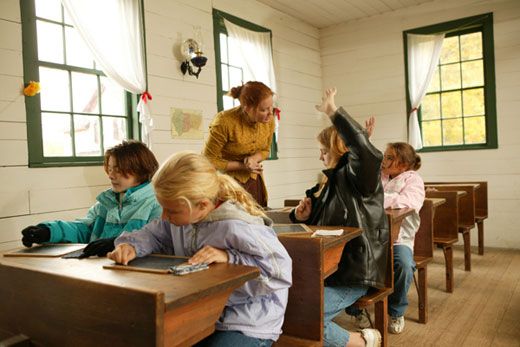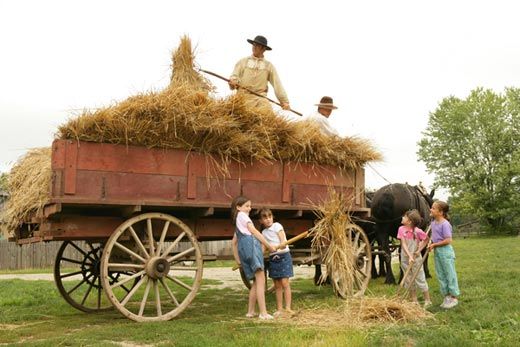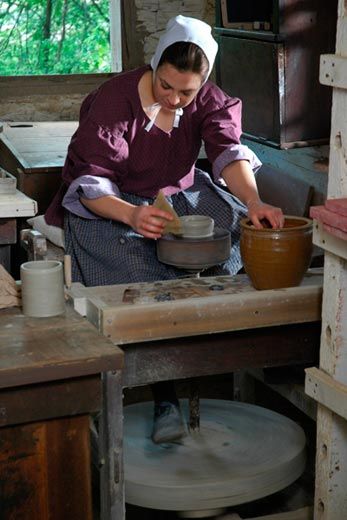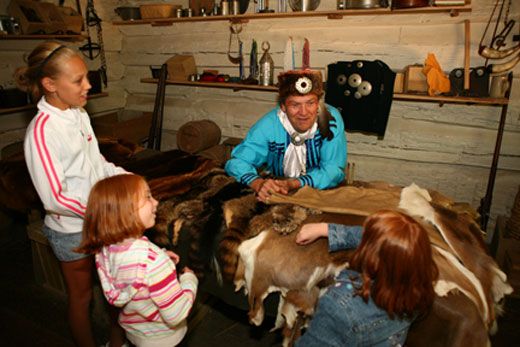Back to the Frontier
At Conner Prairie, Indiana, living history is the main event
Inside a log cabin on the Indiana frontier, a rugged-looking man in a rumpled linen tunic, trousers of rough homespun and heavy black boots sat at a crude table piled high with pelts. He looked up as I stepped inside.
"Welcome," he said. "What furs do you have to trade today?"
Just outside, a fire smoldered near two bark-and-reed huts, the dwellings of local Lenape Indians. In a nearby clearing, a deer hide, dangling inside a wooden frame used for skinning and stretching, dried in the sun. A log shed next to the cabin housed a bark canoe, hung from the rafters.
Only 40 minutes earlier, I had been driving in an air-conditioned car, radio blaring, cellphone at the ready. Now, in backwoods along the White River—only 15 miles northeast of downtown Indianapolis—I had wandered into McKinnen's wilderness trading post (c. 1816). It was, for the trader "McKinnen" and me, all in a day's role-play at Conner Prairie, an 850-acre living-history museum in Fishers, Indiana. Conner Prairie re-creates the everyday life of 19th-century settlers in the Old Northwest Territory (roughly present-day Ohio, Indiana, Illinois, Wisconsin, Michigan and Minnesota).
McKinnen's trading post was stocked with everything a backwoodsman could want—Hudson's Bay blankets, flintlock rifles, hurricane lanterns, leg-hold traps, trinkets, strings of beads and hanging sheaves of dried and braided tobacco leaves. McKinnen fingered the furs on his table, beginning with a stack of glossy brown pelts. "Perhaps you have brought some pelts of beaver for me?" he inquired. "The beaver has thick and slightly oily fur, very good for warmth and repelling water. It's the height of fashion now." He moved on. "Or you have these, from the otter?"
"I have none at all," I replied.
McKinnen paused theatrically and glared. "Sir," he said at last in mock exasperation. "I am compelled to ask: If you don't want to trade...what brings you here?"
This question, at least, I could answer. I had arrived at McKinnen's doorstep to investigate an attraction that brings more than 200,000 visitors here each year from April to October. (Of the nation's living-history museums, only Virginia's Colonial Williamsburg boasts a larger annual attendance, at some 760,000.) Across Conner Prairie's rolling hills and fields, gravel trails link four thematic areas: the Lenape Camp, as the McKinnen post is officially known (c. 1816); William Conner Homestead (1823); Prairietown (1836); and Liberty Corner (1886). At each, staffers in period costumes invite spectators to join in activities from weaving to milking cows.
William Conner, a wilderness trader who prospered on the Indiana frontier in the early 1800s, was the first landowner. In 1934 the Indianapolis-based pharmaceutical tycoon and philanthropist Eli Lilly purchased the property. A self-described "Hoosier nationalist," Lilly restored the house to its former glory, intending, he told the Indianapolis News in 1935, to "give future generations historical understanding not to be found in a book." Over the next three decades, Lilly scoured the Midwest for authentic implements and outbuildings. He transported log cabins, a springhouse, a loom house and a barn to the farm. In 1964, the 78-year-old Lilly, who had invested hundreds of thousands of dollars on the project and envisioned a full-scale living-history museum, opened the restored estate to the public. That same year, he entered an endowment partnership with nearby Earlham College to establish, manage and expand the Conner Prairie Living History Museum. (Lilly died in 1977.) By the mid-1970s, Prairietown had been erected; the Victorian village of Liberty Corner rose from the hayfields by 2002. Among the oldest structures on the property, the cabins of the Lenape trading camp date from the 1830s. (The trading camp was expanded in 2007.)
Today, Lenape Camp staffers, some of whom are Lenape themselves, enact the part of Native Americans, encouraging visitors to tan hides or try their hands at traditional games. Lead interpreter Michael Pace is a Lenape tribesman. He is also the great-great-great-nephew of William Conner, who married a Pace aunt named Mekinges around 1800. "But that's not why I work there every summer," he says. "I do that to keep our language and tribal practices alive and to pass them along to visitors."
At Prairietown, visitors wander into any of a dozen or so buildings, including the Golden Eagle Tavern & Inn; a blacksmith forge; quarters for a doctor; studios for a weaver and a potter; and a general store. Prairietown tourists may also be waylaid by a lieutenant from the Indiana Militia, wearing a brocade uniform and attempting to conscript recruits into his unit, whose men are camped at the edge of town. (To draw attention to their presence, the troops often fire flintlock rifles in unison; the roar is deafening.)
At Liberty Corner, where it's always 1886, passersby may be tapped for a game of vintage baseball (rules call for batters to get three strikes or seven balls). At the Quaker meetinghouse, a vaudeville song-and-dance duo, Simpson & Roberts, headlines a musicale. Or visitors may help bundle newly threshed hay from the outlying fields, tossing sheaves into the back of horse-drawn wagons.
"At Conner Prairie," says Ellen M. Rosenthal, president and CEO of the museum, "visitors can watch, but they can also become involved. We don't want our interpreters just demonstrating and talking. Learning history should be fun." Conner Prairie conducts several immersion programs, including the most popular offering, "Follow the North Star" (November 6-8, 13-15 and 20-22), which enables participants to take on the role of fugitive slaves in the 1850s and '60s. "The experience can be so intense," says Dan Freas, who oversees immersion programs, "that when it's over, we do a debriefing with psychological professionals, to make sure everyone's OK."
However, simply strolling the gravel paths can offer an equally accessible route to time travel. On the day I arrived, after stopping by the Museum Center, where a barbershop quartet was performing, I picked up a map containing the day's schedule of events.
After sampling Lenape Camp, I passed the Conner Homestead, that day the site of a watermelon seed-spitting contest. I continued on the trail, past the homemade ice-cream demonstration (free samples), and entered Prairietown. After pausing at the blacksmith's, where a smithy instructed an apprentice in the art of forging coat hooks, I crossed over to Whitaker's General Store.
"Whitaker," courtly and silver-haired, was snappily attired in a pale cotton suit-vest and matching trousers, a straw dress hat on his head. On his front porch, local children dressed in period clothes hung red, white and blue bunting for the coming Independence Day holiday.
As I entered the shop, I inquired, "Do tell me, what's been selling well lately?" Mr. Whitaker walked behind his shop's wooden counter to lift sets of silver place settings from a shelf. "These have been going into all the young ladies' hope chests," he replied. "They're imported: all the way from Philadelphia."
He returned the silverware to its shelf, and with a glint in his eye, pointed out a book on the counter. "Of course," he added, "I always suggest this goes in their hope chests, too. After all, in this modern age, a girl has to keep up with the times—and knowing the contents in that book there, well, it makes any village girl more attractive as a bride. It's just been published."
Glancing down, I saw a copy of The American Frugal Housewife—and felt as if I had truly been delivered to the 19th century. With an 1833 publication date printed on the cover, I knew that in Prairietown, this helpful little tome was hot off the presses.
Freelance writer Donovan Webster is based in Charlottesville, Virginia.
Planning Your Next Trip?
Explore great travel deals
Smithsonian magazine participates in affiliate link advertising programs. If you purchase an item through these links, we receive a commission.
/https://tf-cmsv2-smithsonianmag-media.s3.amazonaws.com/accounts/headshot/Don4x5.tif)




/https://tf-cmsv2-smithsonianmag-media.s3.amazonaws.com/accounts/headshot/Don4x5.tif)